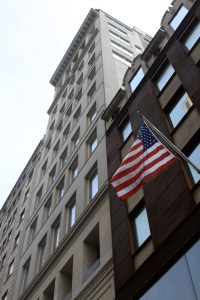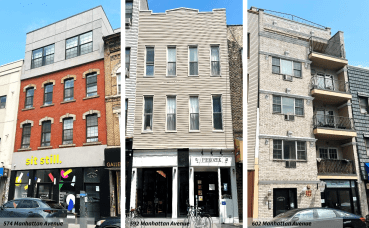Cushman Manuevers Chinese Wall in British Luxury Brand Deal
By Jotham Sederstrom November 8, 2011 9:37 am
reprintsIn 2005, Robert Siegel bought an 18-story building on Fifth Avenue for $86 million.
The Metropole Realty Advisors chief executive had spent 30 years in real estate scooping up prime retail locations on thoroughfares synonymous with luxury fashion and lifestyle brands—Rodeo Drive, Madison Avenue and Kalajaua Avenue, Hawaii’s Luxury Row in Waikiki, to name a few. So when 681 Fifth Avenue went on the block, Mr. Siegel raced to purchase the building in which he had lived from 2001 to 2008.

Indeed, besides being a familiar site, the asset was brimming with potential. With its 14-foot ceilings and enviable Plaza district location, the building, in Mr. Siegel’s opinion, dangled limitless possibilities for an up-and-coming fashion brand vying to become the industry’s next powerhouse, à la Halston in the 1960s.
Which is why in October, he inked a lease transaction with Belstaff, a British producer of motorbike jackets and other upscale luxury goods, for three floors at 681 Fifth Avenue totaling 17,505 square feet.
In Belstaff, which the Swiss luxury goods company Labelux Group acquired in June for a reported $161 million, Mr. Siegel clinched a tenant he described as “one of the best brands coming out in the future.”
For the fashion brand, meanwhile, the lease marked another high point in a recent cascade of exciting benchmarks, including a series of high-profile new hires the label made following last month’s acquisition.
Launched in England in 1924 as a maker of waxed cotton clothing for motorcycle riders, Belstaff grew into a trendy fashion label that, earlier this year, drew interest from Labelux and Tommy Hilfiger, both of which acquired interests in the firm this summer.
The label already had offices in London and Milan, but the new ownership appears focused on establishing a New York office for its North American headquarters, all while keeping an eye on future expansion plans across the country.
Meanwhile, fortified with Labelux and Hilfiger funding, the company hired Martin Cooper, formerly of the Burberry Group, as its new chief creative officer. As chief executive, the label installed Harry Slatkin, best known as the founder of the home fragrance brand Slatkin & Co.
With those new executives installed, Belstaff was fully poised by earlier this year to reposition itself as an all-encompassing luxury lifestyle brand come next fall 2012—all it needed was a tenacious tenant broker.
Enter Cynthia Foster, an executive managing director at Cushman & Wakefield. Already versed in Belstaff and its product as its worldwide broker, Ms. Foster was searching for the company’s new space when she came upon Cushman colleagues Bruce Mosler and Arthur Mirante, the asset’s leasing agents.
“They really fell in love with the building,” recalled Mr. Mirante. “It grew from the macro, which was ‘This building is the perfect image for us’ to ‘I think we’re going to need three floors [rather] than two.’”
With its high ceilings and lack of columns, the building was already a fashionista’s dream. Zanella, an Italian brand that previously leased space at 681 Fifth, regularly hosted fashion shows in the space, which helped reduce “the tremendous rental costs involved [with] holding fashion shows at third-party venues,” wrote Mr. Siegel in an email to The Commercial Observer.
Also helping the landlord’s case in the negotiations was the two years and $20 million spent refurbishing the interiors and exterior of the building, an overhaul that resulted in additional glass partitions and high-end fixtures and finishes that injected a modern, state-of-the-art feel into the 99-year-old former home to the Metropolitan Museum of Modern Art.
“There is no old aspect to the building other than its charm, the front facade and the floor slabs,” said Mr. Siegel.
Prior to the renovations, Metropole spent three years in “amicable” negotiations with the building’s old tenants, eventually buying out each of their leases by 2008.
As the new space repositioned toward fashion and high-end wealth-management firms, Cushman & Wakefield signed Global Thematic Partners, an independent investment management boutique, to 5,835 square feet in the building’s 12th floor.
When lease negotiations commenced, Mr. Mirante built a Chinese Wall between him and his team and Ms. Foster and hers.
When negotiations between Belstaff and Metropole commenced, Mr. Mirante and his team conducted “pretty healthy” discussions with his colleagues on the other side of the Chinese Wall while keeping the same office Belstaff desired on the market place.
“We weren’t counting our chickens by any means at that point,” said Mr. Mirante.
This resulted in a “creative tension” between the two sides of the same firm, arguing over the same building. “It was by no means an insider deal or a family deal,” recalled Mr. Mirante.
Well into their negotiations, both sides agreed that Belstaff was Metropole’s “ideal tenant.”
Metropole also secured a new round of financing worth $150,000,000.
Asking rent at 681 Fifth Avenue floated between the mid-$70s and the mid-80s per square foot on those three floors, said Mr. Mirante. Meanwhile, Belstaff had an option for contiguous space. He would not disclose the final terms of the lease, including the number of years.
Belstaff eventually agreed to three floors—the eighth, ninth and 10th—at nearly 6,000 square feet per floor. The building is entirely leased with the exception of the penthouse Mr. Siegel once occupied. And as proud as he was to have once lived in the building, he’s even more ecstatic about Belstaff’s arrangement.
“To have them select our building … makes me very proud,” said Mr. Siegel.
drosen@observer.com


